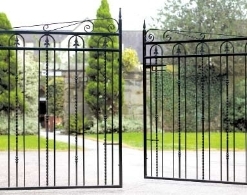
To truly determine the longevity of a gate – expose it to winter! As winter separates the average gate from the good. The freezing temperatures, constant moisture and meagre daylight all expose flaws that summer's best cannot show. Composite and aluminium both boast superior performance in winter, but the outcome is greyer than their marketing brochures might have you believe. And so, the question arises... which one is better? Well in our experience, the answer isn’t an easy one… but we’ve laid it all out for you below.
What Winter Actually Does to Gates
British winter generally brings constant moisture combined with freeze-thaw cycles. The temperature hovers around freezing and crosses that critical threshold repeatedly.
Water expands about 9% when freezing. This expansion force will break almost anything given sufficient cycles. Gates trap water in joints, fixings, and hollow sections. Each freeze causes damage. Each thaw allows more water penetration. By February, cumulative damage becomes apparent.
Reduced sunlight creates conditions where moisture on surfaces persists longer. A gate that might have remained wet only through noon on a summer afternoon continues wet for days into December. This kind of prolonged moisture promotes different mechanisms of deterioration than brief summer rain.
Composite surfaces generally hold up well through winter. They require no painting or staining. That's the primary selling point and it holds true.
Unfortunately, some composites develop surface blooming - a white hazy appearance - when exposed to sustained moisture. This results from moisture drawing salts or additives to the surface. Often temporary and disappears when conditions dry but looks terrible through winter months.
Darker colours of composite show dirt, road spray, and water staining more than lighter colours. Winter gates will look grubbier, since there is constant moisture and reduced cleaning frequency compared with summer.
Structural Performance
Composites lack the inherent strength of aluminium or hardwood. They are dependent upon thickness and construction design for rigidity. Winter loading from wind, ice, or snow will cause sagging in poorly designed gates.
Material creeps under sustained load more than metals. A gate supporting ice accumulation or hanging wrong may not return to original shape when the conditions improve. This permanent deformation is rare but happens with cheaper products.
Aluminium Gate Winter Reality
Aluminium gates prevail in the high-end segment, partly due to excellent winter performance. Not perfect, though: several issues catch owners unprepared.
Temperature Stability
Aluminium expands and contracts with temperature but is otherwise dimensionally stable compared to composites. The expansion coefficient is predictable and consistent.
However, aluminium does move more than steel. Long gates can show noticeable length changes between cold mornings and mild afternoons. Proper installation accounts for this with appropriate clearances and fixing methods.
The metal is a fast conductor of heat. Aluminium gates are much colder to the touch than composite or timber in winter. That matters in the context of automatic gates because sensors and other electronics are attached to metal frames, and temperature extremes can affect electronic components.
Moisture and Corrosion
Pure aluminium doesn't rust. It forms a natural protective oxide layer. Sounds perfect for winter, and generally is, but complications exist.
Aluminium corrosion – in the form of white powdery deposits – can take place even with the protective oxide layer. Winter road salt is a very potent accelerator. The fact that gates near roads which are treated heavily with salt show corrosion faster than sheltered positions is evidence of this.
Dissimilar metal contact causes galvanic corrosion. Steel fixings in aluminium frames corrode rapidly with winter moisture present. Quality installations use appropriate fixings. Cheaper installations cut corners here and problems emerge quickly.
Performance of Powder Coating
Aluminium gates use powder coating for appearance and additional protection. Good quality powder coating withstands winter perfectly, while poor coating fails quickly.
Winter reveals coating flaws which summer hides. Chips or thin spots allow moisture beneath the coating. Frost then lifts the coating further. Small damage in November becomes obvious coating failure by February.
Dark colours reveal surface defects much more. Scratches, stone chips, or handling marks that barely showed in summer are shown starkly against winter's grey backdrop.
Operational Reliability
Aluminium gates maintain reliability through winter better than any alternative. They do not swell, warp, or stick like timber does; nor do they have the creep issues composites show.
Hinges and hardware function predictably. Hardware in either stainless steel or aluminium, matching the gate material, eliminates galvanic corrosion problems. Lubrication lasts longer on metal surfaces than on porous materials.
In general, automated aluminium gates work reliably throughout winter provided that the electronics are well-protected. The mechanical elements rarely fail in such conditions. Most electronic components caused winter automation problems irrespective of the gate material.
Direct Comparison Points
Initial Cost
Aluminium can be much more expensive upfront. A lot more than others for the same size and requirements. Composite gates fill in the pricing gap between inexpensive softwood and high-end aluminium.
Maintenance Needs
Both materials claim to be low maintenance. True compared to timber, but neither is maintenance-free.
Composites require washing periodically. Power washing works, but high pressure can damage the cheaper varieties. Annual inspection for loose fixings is important since the material does not grip screws as well as timber does.
Aluminium generally needs less maintenance - wash occasionally, check coating condition, lubricate hinges. More forgiving of neglect than composites.
Winter Appearance
Aluminium holds up better through winter - based on our experience. Powder coating resists staining and weathering and the gates look essentially identical in December as compared to September.
Composites however are more variable. Moisture-related surface changes, dirt retention and general dulling can occur. This does recover somewhat in spring but winter appearance disappoints for some homeowners.
Security Performance
In our experience, Aluminium offers better security. The overall material strength is much higher compared to composite - for the desired purpose. Forced entry involves more efforts, with greater noise - making it more secure.
Composites can be cut or broken more easily. Not a major concern for most residential applications but does matter for high-security requirements.
Life Expectations
Quality aluminium gates typically should last around 25-30 years or more with minimal maintenance. Powder coating might need refurbishment after 15-20 years depending on exposure.
Composite gates typically last around 15-20 years. Some premium products claim longer but track record is limited since the material is relatively new to the marketplace. Certainly, however the winter performance degrades more noticeably over time compared to aluminium.
Which Actually Performs Better?
Winter performance favours aluminium for most applications and situations. The material comprehensively handles temperature swings, moisture, and operational demands more reliably than composites. Composites however have their advantage in certain conditions.
For exposed locations with harsh winter conditions, the extra cost of aluminium will be justified. Coastal properties, elevated sites, or gates in full-weather exposure perform better with aluminium.
Sheltered locations with moderate winter conditions suit composites acceptably. Urban settings with surrounding buildings providing some weather protection. Gates primarily decorative rather than security-focused.
What’s the Final Verdict?
One of the first things to consider is weather exposure. How much variance does your particular location receive in terms of the weather? Sheltered positions are more forgiving of material limitations.
Aesthetic preferences certainly count too and should not be overlooked too much of course. Some people strongly prefer the appearance of composite. Others want the clean, modern look of aluminium. Neither choice is wrong if made with a clear understanding of the performance differences.
In terms of winter performance specifically? We would say that Aluminium wins for reliability, longevity, and consistent operation. Composites work acceptably in favourable conditions but show more issues when winter turns harsh.
The material choice determines whether you're confident your gates will work reliably through January and February or whether you're hoping they'll make it through winter without problems. That difference justifies aluminium’s premium pricing for many homeowners. And if you’re looking to buy a new aluminium gate, be sure to check out our range.



